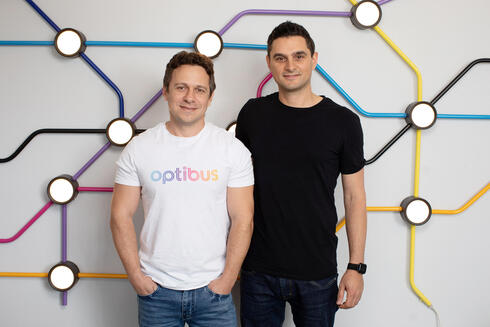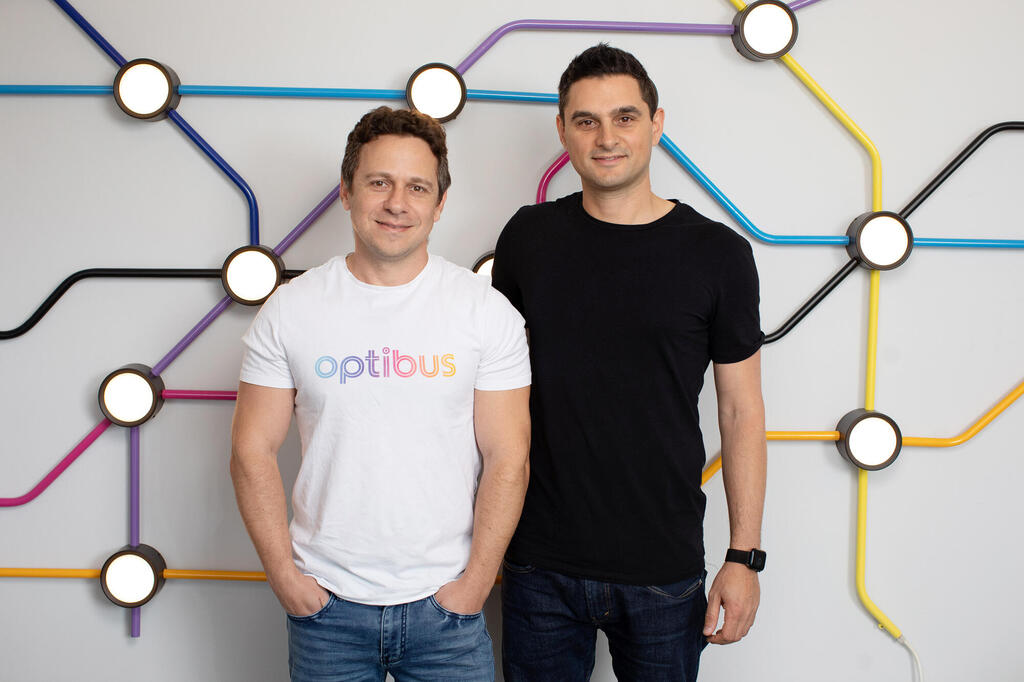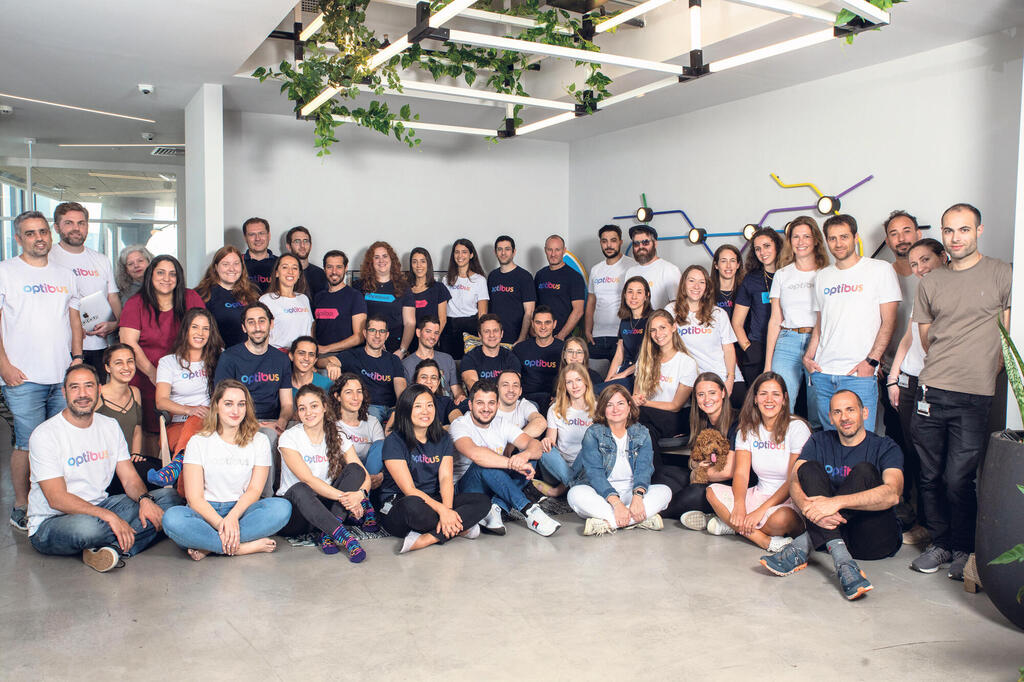
Top 50 Startups List
Optibus is bringing public transportation into the 21st century
The Israeli startup started off as an intellectual challenge but is now active in over 1,000 cities, generating tens of millions of dollars in annual revenue
This is not another of those stories of two guys who served in one of the IDF’s technology units and had an idea for a startup. Amos Haggiag and Eitan Yanovsky didn’t serve in Unit 8200 and didn’t know each other before coincidentally meeting while studying computer science and math at Ben Gurion University. Even after they met and started working together on something reminiscent of a startup during the first year of their studies, they almost gave up on the idea and each started careers as employees at other companies. They still occasionally met to talk and discuss the idea, but it was more of an intellectual challenge, a sort of unsolvable math problem, which both of them as fans of riddles from childhood, were trying to crack for years. It was only almost a decade later that they felt they were close to the solution and made the difficult decision to leave their cozy jobs and founded Optibus, which solves the problem of managing and planning mass transportation, a significant pain point, albeit not technological in its essence.
How do you ensure a bus is available at all the right stops and at the correct times while traveling the minimal distance? What route do you allocate to a driver who has arrived in Beit Shemesh from Tel Aviv but won’t be making the return journey for two hours? How do you reach a balance among public transport drivers in order to avoid one driver registering significant overtime while another doesn’t reach his required allotment? When would it be best for a driver to take a day off? And how in the world do you decide where it is best to park the bus so that it will be close to its route the following day but also convenient for the driver to reach?
All of these problems, and a few others, are solved by the software that was ultimately developed by Amos Haggiag, who serves as CEO of the company, and Eitan Yanovsky, the CTO. The platform is already operational in over 1,000 cities and generates revenue of tens of millions of dollars a year, a sum that has doubled itself over the past two years. Optibus clients pay an annual subscription for the software, the price of which is determined according to the number of vehicles they are managing. Contracts are usually signed for periods of between 3-5 years.
Optibus is different from most Israeli startups also when it comes to the market it targets. While most local startups have their sights set on the international market from day one, and mainly the U.S. market, Optibus’ first clients were Israel’s public transport companies. Optibus now dominates the local market, including public transportation company Egged, and doesn’t treat the U.S. as a main market. It is in developed countries that there is a particularly high demand for Optibus’ platform due to the number of people using public transport in those regions. While public transport and buses may sound like a boring low-tech business, the Big Tech companies are among those to have taken note of Optibus, with Mark Zuckerberg himself using shuttle systems planned by the Israeli company. “Some of our clients are big companies with dozens and hundreds of employees who have reached a situation in which they are building their own public transport systems. We currently plan all employee shuttle services for Apple, Amazon, Microsoft and Facebook in the U.S. These are employees that are used to sitting for an hour-and-a-half in traffic in each direction. Now there are hundreds of buses leaving every 10 minutes and taking them to wherever they need to go and Mark Zuckerberg himself takes such a bus to work. Around 80% of Facebook employees take a bus to work every day,” Haggiag told Calcalist.
Like Zuckerberg, Haggiag also avoids using a car. Today, after already raising $170 million and almost reaching unicorn status in their most recent funding round which included many of the big name VCs, Haggiag and Yanovsky, are determined to buck all the stereotypes. This also resonates with the rest of the employees at the company, which already employs more than 300 people. Haggiag, who was raised in Tel Aviv and still lives in the city, travels to the company’s headquarters on Hashalom Road in Tel Aviv on the same bus routes he used as a child, although he does so with a different perspective these days. “A bus is the most effective mode of transportation and in Tel Aviv I only travel via bus, bike or foot,” noted Haggiag.
Out of principle and loyalty to its technology, Optibus only has five parking spots for its 150 employees in its Tel Aviv office. According to Haggiag, and regardless of Covid-19, even those spots aren’t always filled. In order to encourage employees to adopt public transport, or at least reduce their use of a car, every employee who joins the company receives a free electric bike or scooter. This solves another problem many tech companies face in employee recruitment. “There are many employees who look for us and join us because they have a passion for public transport and want to work at a place like this out of principles of a green economy and sustainability. These people are called transit geeks. They have Facebook groups across the world and often they approach us as we are almost the only company in the world which is making public transport more efficient.”
Haggiag and Yanovsky weren’t always transit freeks. It all started with Haggiag’s father who has served for over a decade as the CFO of bus company Kavim. When Haggiag began his university studies, his father challenged him to develop software that would solve a seemingly simple problem of planning bus routes and making them more efficient.
“I told Eitan about the problem and it really interested the both of us because it was fascinating as a puzzle. It reminded us of the famous traveling salesman problem - how to correctly plan the day of a salesman who needs to visit 100 customers at different addresses. It is a problem that is very easy to explain, but it is impossible to solve, with a computer requiring an infinite amount of time to calculate the numerous different options,” explained Haggiag.
Even though both of them spent countless hours trying to solve the bus problem, Haggiag would leave for Princeton following his studies in Israel and after returning joined Microsoft Israel’s team that developed Cortona, the company’s answer to Apple’s Siri. In the meantime, Yanovsky was moving up the ladder at GigaSpaces and completed his second degree in computer science. “Throughout all these years we continued toying with this idea during our free time, mainly on weekends and holidays. We wrote some code, took some data from Israeli’s public transport companies, mainly the smaller ones, and as time passed began to understand that we had something that works and provides a reasonable result. We never thought that this could be an actual company and something big.”
When did you understand that it works and that it has potential?
“It took us a long time. We were certain that this was a problem that only existed in Israel and that in the U.S. or Europe public transport systems were being managed in a far more efficient manner. We were surprised to discover that this was a global problem and there was great demand from all the companies in Israel that had heard from other companies that the product works.”
In what way did it work for them?
“We saved them on operational expenses even with our very initial product after taking all the public transport data in a specific city and creating a work plan for buses and drivers at a reduced cost. It reduced millions and maybe even tens of millions a year in operational expenses. Reducing costs is something dramatic for public transport companies that receive money from the state to operate transportation. Our product is far more complex these days and also addresses planning different combinations, and optimizing the timetables of trains and light rail. For example, our system was used by the Tel Aviv light rail to determine its timetables, frequency, drivers, and how many staff members are required.”
As a public transport freak, do you believe the light rail will succeed?
“Very much so. This will be a big revolution and it is coming soon. It will be packed and will substitute many cars as well as buses.”
If your idea and product are so good and there is such demand for it, how come you don’t have any competitors?
“There are hundreds of companies that compete with us but we don’t have any competition. Wherever we go there are usually one or several products, but they are out of date and don’t provide a modern solution with algorithms and machine learning. This is a big problem and it exists around the world. However, in the past, public transportation companies tried to solve it themselves. Egged, for example, developed its own in-house platform. We are substituting these platforms, but it isn’t easy as these are products that companies have been using for 40 years.”
How do you make sure that the platform is in use after it was purchased?
“One hundred of our 300 employees are in customer success and are in touch with the clients and talk to them in their language.”
How frequently is the platform used and which departments use it?
“It is used by the driver, by the person managing parking, by the control center that needs to solve a surprise traffic jam and by the planning department that wants to prepare for increased demand during the holiday season. Almost everyone has some contact with an aspect of the platform at some stage.”
What are your growth directions?
“We are busy expanding globally. We are already active in 25 countries in every continent. We are growing very rapidly in America and Europe. We serve almost 60% of all public transport in England, including all the big cities like London, Manchester and Liverpool. We serve 85% of Scotland. We have now started in Africa with a big contract in Kampala, Uganda.”
Does a startup have the capabilities to expand globally in such a way?
“We will continue doing this and enter more countries. We have just started in India. The reason we are doing this is that the public transport market is very different from other markets that are mainly centered in the U.S. It is mainly in the non-developed regions that public transport is more developed. Our product requires almost no adaptations between countries and the problem is universal. The second thing we are doing is expanding the product. We bought a company earlier this year and will make several other acquisitions. For example, as the world moves to electric buses, we want to also get into management of charging platforms. Other fields we’d like to expand into are vehicle maintenance and parking.”
Where will Optibus be five years from now?
“We will be a public company. We aren’t planning to be acquired. This doesn’t suit our industry and there is no buyer for a platform like this. Usually you look to be acquired when you understand that you can’t be the market leader, but we estimate that we will control this market. We are a SaaS company with wide profit margins. We have an almost 100% client retention rate, with most clients staying for five years or more. We don’t have to advertise to bring in clients and that is very efficient. We mainly take part in conferences and do webinars as clients bring with them other clients. Every index shows that we can be very successful as a public company.”















